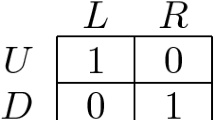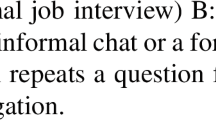Abstract
This article aims to provide foundations for a new approach to Agent Communication Languages (ACLs). First, we present the theory of signalling acts. In contrast to current approaches to communication, this account is neither intention-based nor commitment-based, but convention-based. Next, we explore ways of embedding that theory within an account of conversation. We move here from an account of the basic types of communicative act (the statics of communication) to an account of their role in sequences of exchanges in communicative interaction (the dynamics of communication). Finally, we apply the framework to the analysis of conversational protocols such as the English auction protocol. We propose to give a compact expression of conversation protocols by means of a formula of the object-language. We also use this kind of representation to provide the basis for a procedure for keeping a record of the conventional effects achieved in a conversation. A corresponding axiomatic presentation is given, and shown to be sound and complete with respect to our proposed semantics.
Similar content being viewed by others
References
Artikis, A., J. Pitt and M. Sergot (2002). “Animated Specifications of Computational Societies,” In: Castelfranchi C. and Johnson L. (eds.), Proceedings of Conference on Autonomous Agents and Multi-Agent Systems (AAMAS), pp. 1053–1062
Artikis, A., M. Sergot and J. Pitt (2003). “Specifying Electronic Societies with the Causal Calculator,” In: F. Giunchiglia, J. Odell and G. Weiss (eds.), Proceedings of Workshop on Agent-Oriented Software Engineering III (AOSE), Springer
Austin, J. L. (1962). How to do Things with Words, Oxford: Oxford University Press
Bennett, J. (1976). Linguistic Behaviour, Cambridge: Cambridge University Press
Blackburn P., de Rijke M., de Venema Y. (2001). Modal Logic. Cambridge University Press, Cambridge
Brandom R. B. (1983). Asserting. Nous 17:637–650
R. B. Brandom (1994). Making it Explicit – Reasoning, Representing, and Discursive Commitment. Harvard University Press, London, England
Brown, P. and S. C. Levinson (1987). Politeness – Some Universals in Language Use. Cambridge: Cambridge University Press
Carmo, J. and A. J. I. Jones (2002). “Deontic Logic and Contrary-to-duties,” In: D. Gabbay and F.␣Guenthner (eds.) Handbook of Philosophical Logic, Vol. 8, 2nd edn. Dordrecht, Holland: Kluwer Academic Publishers, pp. 265–343
Chavez, A. and P. Maes (1996). “Kasbah: An Agent Marketplace for Buying and Selling Goods,” In: Proceedings of the 1st International Conference on the Practical Application of Intelligent Agents and Multi-Agent Technology (PAAM-96), London, UK, pp. 76–90
B. F. Chellas (1980). Modal Logic – An Introduction. Cambridge University Press, Cambridge
Cohen, P. R. and H. J. Levesque (1991). “Confirmations and joint action,” In: Proceedings AJCAI-91, pp.␣951–957
Colombetti, M. (2000). “A Commitment-based Approach to Agent Speech acts and Conversations,” In: Proceedings of the Workshop on Agent Languages and Conversation Policies, Barcelona, pp. 21–29
Cost R. S., Chen Y., Finin T., Labrou Y., Peng Y. (2000). Issues in Agent Communication – An Introduction, In: Dignum F., Greaves M. (eds.), Issues in Agent Communication. Springer-Verlag, Holland, pp. 178–192
Delgrande, J. (1988). “An Approach to Default Reasoning Based on a First-order Conditional Logic,” Artificial Intelligence, 36, 63–90
Elgesem, D. (1993). Action Theory and Modal Logic. PhD thesis, Institutt for filosofi. Det historik-filosofiske fakultetet. Universitetet i Oslo. See also Elgesem’s paper ‚The modal logic of agency’ cited below
Elgesem D. (1997). The Modal Logic of Agency. Nordic Journal of Philosophical Logic 2(2):1–47
Ferber, J. (1995). Les Systèmes Multi-Agents – Vers une Intelligence Collective. InterEditions
Fitting M. (1983). Basic Modal Logic. in: Hogger C., Gabbay D. M., Robinson J. (eds.), Handbook of Logic in Artificial Intelligence and Logic Programming, Vol: 1. Oxford University Press, Oxford
Føllesdal D. (1967). Comments on Stenius’s ‚Mood and Language Game’, Synthese 17:275–280
Grice H. P. (1957). Meaning. The Philosophical Review 66:377–388
Grosz B. J., Sidner C. L. (1990). Plans for Discourse. in: Cohen P. R., Morgan J., Pollack M. E. (eds.), Intentions in Communication. MIT Press, Cambridge, pp. 417–444
Heritage, J. (1984). Garfinkel and Ethnomethodology. Cambridge: Polity Press
Hilpinen R., Follesdal D. (1971). Introduction to Deontic Logic. in: Hilpinen R. (eds.), Deontic Logic. D. Reidel Publishing Company, Dordrecht
Jones A. J. I. (1983). Communication and Meaning – An Essay in Applied Modal Logic. D. Reidel, Dordrecht, Holland
Jones A.J.I. (2002). On the Concept of Trust. Decision Support Systems 33:225–232
Jones, A. J. I. (2004). “On Normative- Informational Positions,” In: A. Lomuscio and D. Nute (eds.) Deontic Logic in Computer Science: Proceedings of the 7th International Workshop (DEON 2004), Vol. 3065 of Lecture Notes in Artificial Intelligence. Berlin: Springer, pp. 182–190
Jones A. J. I., Kimbrough S. O. (2005). A Note on Modelling Speech acts as Signalling Conventions. in: Kimbrough S. O., Wu D. J. (eds.), Formal Modelling in Electronic Commerce, International Handbooks on Information Systems. Springer Verlag, Berlin, Germany, pp. 325–342
Jones, A. J. I. and S. O. Kimbrough (2006). “On the Normative Aspect of Signalling Conventions,” In: L. Goble and J. -J. Ch. Meyer (eds.), Proceedings of the Eighth International Workshop on Deontic Logic in Computer Science (DEON06), Lecture Notes in Computer Science, Berlin, July 2006, Springer (Forthcoming)
Jones, A. J. I. and X. Parent (2004). “Conventional Signalling Acts and Conversation,” In: F. Dignum (ed.) Advances in Agent Communication, Vol. 2922 of Lecture Notes in Artificial Intelligence. Berlin, Heidelberg, New York: Springer-Verlag, pp. 1–17
Jones, A. J. I. and M. Sergot (1992). “Formal Specification of Security Requirements Using the Theory of Normative Positions,” In: Y. Deswarte, G. Eizenberg and J.-J. Quisquater (eds.) Computer Security – ESORICS 92, Vol. 648 of Lecture Notes in Computer Science. Springer-Verlag, pp. 103–121
Jones, A. J. I. and M. Sergot (1996). “A Formal Characterisation of Institutionalised Power,” Journal of the Interest Group in Pure and Applied Logic, 4, 427–443. Reprinted in E. Garzón Valdés et al. (eds.) Normative Systems in Legal and Moral Theory – Festschrift for Carlos E. Alchourrón and Eugenio Bulygin. Duncker & Humblot, Berlin, Germany, pp. 349–367
Kanger S. (1972). Law and Logic. Theoria 38:105–132
Kimbrough, S. O., A. S. Abrahams, A. J. I. Jones, D. Eyers and J. Bacon (2005). “Introducing the Fair and Logical Trade Project,” In: C. Bartolini, G. Governatori and Z. Milosevic (eds.) Proceedings of the Workshop on Contract Architectures and Languages (CoALa 2005). Enschede, Holland: IEEE Press
Labrou, Y. and T. Finin (1997). “Semantics and Conversations for an Agent Communication Language,” In: M. E. Pollack (ed.) Proceedings of the Fifteenth International Joint Conference on Artifical Intelligence (IJCAI-97). Nagoya, Japan: Morgan Kaufmann Publishers, pp. 584–591
Levi I. (1996). Review of: Making it Explicit. Journal of Philosophy 93:145–158
Lewis D. K. (1969). Convention: A Philosophical Study. Harvard University Press, Cambridge
Lin F., Norrie D.H., Shen W., Kremer K. (2000). A Schema-based Approach to Specifying Conversation Policies. in: Dignum F., Greaves M. (eds.), Issues in Agent Communication. Springer-Verlag, Holland, pp.193–204
Litman D. J., Allen J. F. (1990). Discourse Processing and Commonsense Plans. in: Cohen P. R., Morgan J., Pollack M. E. (eds.), Intentions in Communication. MIT Press, Cambridge, pp. 365–388
Marx, M. (1996). “Dynamic Arrow Logic,” In: M. Marx, M. Masuch and P. Polos (eds.), Arrow Logic and Multi-Modal Logic. CSLI Publications, pp. 109–129
McBurney P., Parsons S. (2002) Games that Agents Play: A Formal Framework for Dialogue Between Autonomous Agents. Journal of Logic, Language, and Information – Special issue on logic and games 11:315–334
McBurney, P., S. Parsons and M. Johnson (2002). “When are Two Protocols the Same?”, In: AAMAS Workshop on Agent Communication Languages and Conversational Policies (ACL-02), Bologna, Italy, pp. 71–78
Parunak, H. V. (1996). “Visualizing Agent Conversations: Using Enhanced Dooley Graphs for Agent Design and Analysis,” In: Proceedings of the Second International Conference on Multi-agent Systems (ICMAS96), AAII Press, pp. 275–282
Pörn I. (1970). The Logic of Power D. Reidel Publishing Company, Dordrecht
Pörn I. (1977). Action Theory and Social Science D. Reidel Publishing Company, Dordrecht
Pörn I. (1989). On the nature of a social order. in: Fenstad J.F., et al. (eds.), Logic, Methodology and Philosophy of Science VIII. Elsevier Science Publishers B.V., New York, pp. 553–567
Pitt, J. (1999). “An Operational Semantics for Intentional Specifications of Agent Behaviour in Communication Protocols,” In: M. Greaves (ed.), Proceedings AA2000 Workshop on Agent Languages and Conversation Policies. Barcelona: AAII Press, pp. 31–40
Pratt, V. R. (1976). “Semantical Considerations on Floyd-Hoare logic,” In: Proc. 17th IEEE Symp. on Foundations of Computer Science, pp. 109–121
Reed, C. (1998). “Dialogue Frames in Agent Communication,” In: Proceedings of the Third International Conference on Multi-Agent Systems (ICMAS-98). New York: IEEE Press, pp. 246–253
Santos, F., A. J. I. Jones and J. Carmo (1997). “Responsibility for Action in Organisations: A Formal Model,” In: G. Holmström-Hintikka and R. Tuomela (eds.), Contemporary Action Theory, Vol. II of Synthese Library 267. Dordrecht, Holland: Kluwer Academic Press, pp. 333–350
Searle J. R. (1969). Speech Acts – An Essay in the Philosophy of Language, Cambridge University Press, Cambridge
Searle J. R., Vanderveken D. (1985). Foundations of Illocutionary Logic, Cambridge University Press, Cambridge
Segerberg K. (1989). Bringing it About. Journal of Philosophical Logic 18:327–347
Sergot M. (1999). Normative Positions. in: McNamara P., Prakken H. (eds.), Norms, Logic and Information Systems. IOS Press, Amsterdam, pp. 289–308
Singh M. P. (1998). Agent Communication Languages: Rethinking the Principles. IEEE Computer 31(12):40–47
Smith, I. A., P. R. Cohen, J. M. Bradshaw, M. Greaves and H. Holmback (1998). “Designing Conversation Policies using Joint Intention Theory,” In: Proceedings of the Third International Conference on Multi-Agent Systems (ICMAS-98). IEEE Press: New York
Stenius E. (1967). Mood and Language Game. Synthese 17:254–274
van Benthem J. (1991). Language in Action. The MIT Press, Amsterdam
van Benthem J. (1994.) A Note on Dynamic Arrow Logics. in: van Eijck J., Visser A. (eds.), Logic and Information Flow. MIT Press, Cambridge, pp. 15–29
van Benthem J. (1996). Exploring Logical Dynamics. CSLI Publications, Stanford, California
de Venema, Y. (1994). “A Crash Course in Arrow Logic,” In: M. Marx, M. Masuch and P. Polos (eds.) Arrow Logic and Multi-modal Logic. CSLI Publications, pp. 3–34
Verdicchio, M. and M. Colombetti (2004). “A Logical Model of Social Commitment for Agent Communication,” In: F. Dignum (ed.). Advances in Agent Communication, Vol. 2922 of Lecture Notes in Computer Science. Springer, pp. 128–145
Walton, D. N. and E. C. W. Krabbe (1995). Commitment in Dialogue. Albany: State University of New York Press
Acknowledgements
This research was supported by the EU funded 5th Framework project ALFEBIITE (IST--1999--10298). The preparation of this paper continued during the EU funded Working Group iTrust (IST--2001--34910) and the EU funded 6th Framework Integrated Project TrustCoM (IST--2002--2.3.1.9). This support is gratefully acknowledged.
Author information
Authors and Affiliations
Corresponding author
Additional information
This paper is a revised and considerably extended version of Jones and Parent (2004). Some of the material included herein appeared in the document ‚A Logical Framework’, written by Andrew J. I. Jones, an unpublished chapter that formed part of the deliverables from the project ALFEBIITE (to which reference is made in the concluding acknowledgements).
Rights and permissions
About this article
Cite this article
Jones, A.J.I., Parent, X. A Convention-based Approach to Agent Communication Languages. Group Decis Negot 16, 101–141 (2007). https://doi.org/10.1007/s10726-006-9059-1
Received:
Revised:
Accepted:
Published:
Issue Date:
DOI: https://doi.org/10.1007/s10726-006-9059-1




